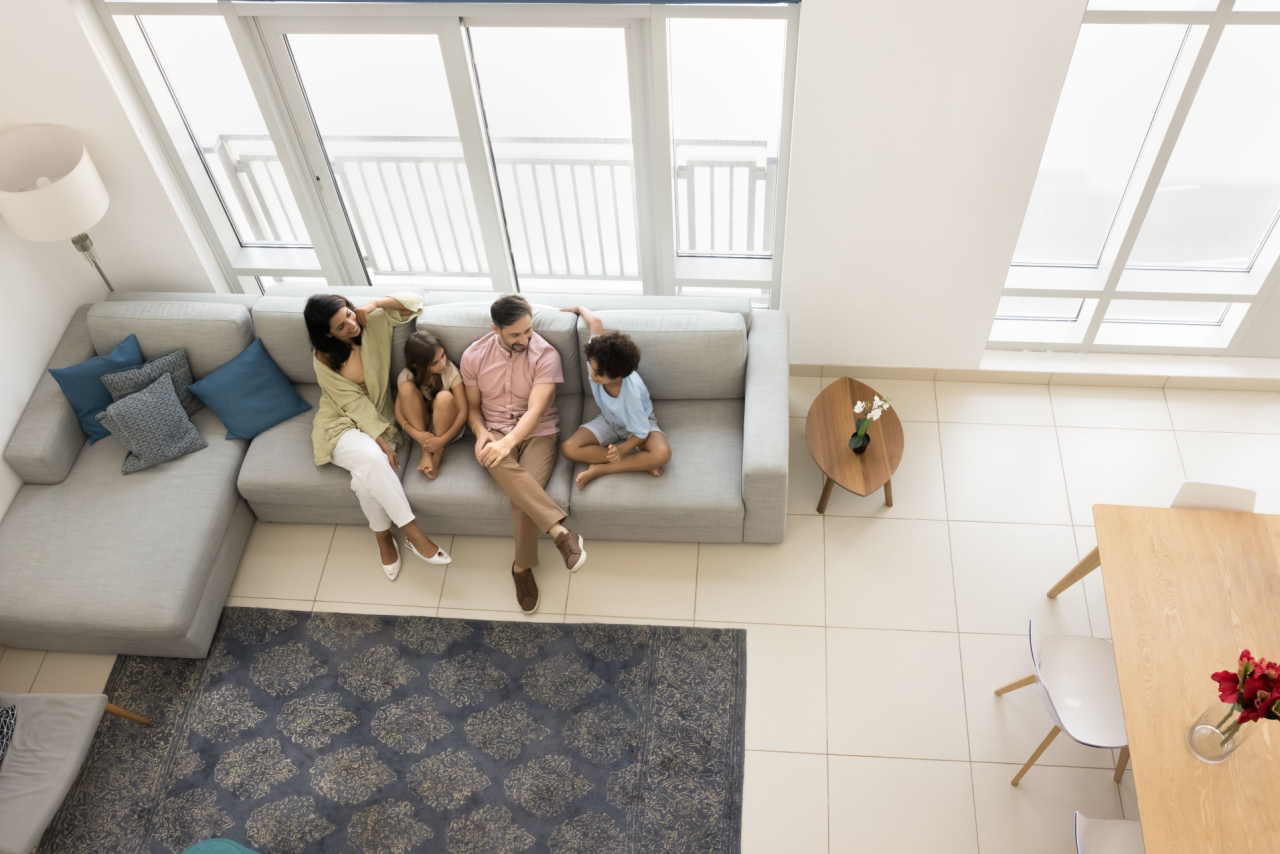San Francisco and New York Leading the Charge

U.S. Average Apartment Size Is Increasing
As we kick off the rental season, square footage has emerged as the new currency in the apartment market, with larger rentals gaining momentum. Our annual analysis shows a significant shift in the U.S. rental landscape: the average size of new apartments expanded again in 2024, reversing a decade-long trend of shrinking floor plans. The most substantial space gains are appearing in several Coastal and Sunbelt cities, giving renters fresh options for more spacious living.
Key Takeaways:
- The average apartment size in the U.S. increased in 2024, reaching 908 square feet, as most unit types expanded their living spaces.
- Studios, one- and two-bedroom apartments got larger, adding between 4 and 13 square feet to their floorplans.
- Two Florida destinations, Tallahassee and Gainesville, claim gold and silver among the cities with the largest apartments.
- Seattle holds on to its top spot as the city with the smallest apartment size in the U.S.
- Apartments in San Francisco have expanded the most among large cities, gaining 59 square feet in the last decade compared to the previous one. It’s followed by Queens, where renters gained 39 square feet.
To give renters a better overview of their options when it comes to living larger, RentCafe.com considered the size of apartments across the 100 largest renter hubs in the U.S. as of February 2025. We looked not only at the cities with the biggest and smallest apartment sizes, but also at the cities which saw the most significant gains in square feet in the last 10 years compared to the decade before.
Among the cities with the largest apartments, Florida’s Tallahassee and Gainesville now lead the nation in apartment size, reversing their positions from last year. Meanwhile, apartments in Seattle and Portland, OR, remain the smallest in the U.S.
On the other hand, several other large hubs such as San Francisco and New York boroughs Queens and Brooklyn have experienced significant growth in apartment sizes over the past decade. Notably, San Francisco added an average of 59 square feet per unit — equivalent to the space needed for a small patio — while Queens and Brooklyn have expanded by 39 and 6 square feet, respectively.
However, the real winner when it comes to the expanding size of rentals is Marietta, GA, as the typical new apartment here (built in the last decade) gained 100 square feet compared to rentals built before 2015. Additionally, Cleveland ranked third among the nation’s largest cities thanks to an impressive gain of 57 square feet in apartment size.
More room to stretch: Small apartments and two-bedroom units are getting larger
Over the past decade, smaller units such as studios and one-bedroom apartments have gained additional square footage, with two-bedroom units following a similar trend. Moreover, one-bedroom units remained the preferred choice of developers in 2024 and in the last 10 years, as they accounted for 48% of newly built apartments. On the other hand, three-bedroom apartments have shrunk during the last decade, with two-bedroom apartments following suit.
With studios and one-bedrooms dominating the rental market — accounting for 52.7% of new units — small apartments, followed by two-bedrooms, continue to dictate the trend for more living space. This has impacted the overall apartment size in the U.S. as well, leading to an average of 908 square feet in 2024.
In terms of unit size, studios have grown the most, adding 13 square feet in 2024 to reach an average of 457 square feet, up from 444 square feet in 2023. One-bedroom apartments have also expanded slightly, increasing by 6 square feet to an average of 735 square feet, while two-bedroom units now measure 1,097 square feet — both appealing choices for renters seeking additional living space.
In contrast, in response to evolving market demands for cities where location is more important than size, developers have scaled down three-bedroom apartments, which now average 1,336 square feet. This is a reduction of 15 square feet from the previous year. Despite this decline, these units still provide ample space for families or renters in need of extra room, particularly in cities where affordability and spacious living options remain top priorities.
Free Rental Application
Get 20 Rental Forms for FREE, including a rental application.
Tallahassee, FL, offers roomiest apartments among largest 100 cities across the nation
Southern cities continue to provide the most floor place, allowing renters more room to stretch their legs. Specifically, Tallahassee, FL, ranks first among the 100 cities we analyzed thanks to an average of 1,130 square feet for new units completed in the last 10 years.
Even so, apartments in this popular Sunbelt destination have actually shrunk by 49 square feet compared to those built before 2015, due to the share of two- and three-bedroom apartments growing smaller. Still, rentals here provide generous living spaces, particularly for students and professionals drawn to the city’s university-centered lifestyle.
Second place was taken by Gainesville, FL, where the average size for apartments built in the past decade reached 1,122 square feet after gaining 11 square feet — perfect for an extra closet if you’re in need of storage. This added space enhances the appeal of the renter lifestyle in Gainesville, which caters to both students at the University of Florida and residents looking to balance affordability and comfort.
Baton Rouge, which ranks third among the cities with the largest apartments, also saw an increase of 11 square feet leading to an average size of 1,055 square feet. Next on our list is Knoxville, TN, where the average apartment size reached 1,041 square feet, while Marietta, GA, rounds out the top five. Here, rentals also average 1,041 square feet, which is an incredible 100 square feet more than apartments built before 2015 — the equivalent of a small home office.
Large hubs are losing living space, with San Francisco, Manhattan, Queens, NY, as the exceptions
While major urban hubs have long been associated with compact living spaces, this trend has begun to shift, with cities like San Francisco and New York’s Queens and Manhattan seeing an increase in apartment sizes compared to rentals built before 2015.
However, most cities are still experiencing a decline in square footage. For instance, Seattle, WA, ranks first among cities with the smallest new apartments, with units completed between 2015 and 2024 averaging 649 square feet. That’s a 57-square-foot decrease compared to older rentals.
Right behind it is Portland, OR, where apartments shrunk by 79 square feet, leaving renters with 668 square feet of space — a challenging adjustment for those seeking extra space in this Pacific Northwest destination.
On the other hand, Queens and Brooklyn, which are traditionally known for their cozier apartments have surpassed the 700-square-foot threshold, reaching 702 and 708 square feet, respectively. This comes after rentals in both locations gained a few extra square feet in the last decade — 39 and 6 square feet, respectively — and in the case of Queens, due to developers focusing on increasing the share of two- and three-bedroom apartments.
Finally, San Francisco rounds out the top five, breaking past the 700-square-foot mark with an average apartment size of 716 square feet. That’s 59 square feet more than a decade ago — just enough space for a cozy reading corner or a tucked-away sleeping nook. This incredible growth is revising an old trend towards smaller living spaces, driven by a surge in the share of two-bedroom apartments. Coupled with studios also getting roomier by 70 square feet, it’s clear that developers are answering to the demand for more space in the Golden Gate City.
Another noteworthy mention is Manhattan ranking at #7 for the smallest apartment size nationwide — 738 square feet. However, new rentals here are 4 square feet more spacious compared to those that opened their doors before 2015. This is thanks in large part to one- and two-bedroom apartments getting roomier during the past decade by 15 and 71 square feet, respectively, allowing Manhattanites just enough space for a small pet without needing to compromise on that mini fridge.
Apartments in large Sunbelt and Coastal cities are getting larger
Renters who are looking for more elbow room should set their sights on Marietta, GA, where apartments gained an extra 100 square feet compared to those completed between 2005 and 2014. This is the most significant expansion in apartment size among the nation’s largest cities. In fact, this Atlanta suburb surpassed both Tallahassee and Gainesville — the nation’s top two cities for apartment size — when it comes to apartment size growth. This is a result of developers in Marietta focusing on expanding the size of one-bedroom units and bringing more two- and three-bedroom apartments online.
Next on the list is San Francisco, where the average new apartment offers an extra 59 square feet compared to older units. Third is Cleveland, where the average size of new units increased by 57 square feet. In fourth place we have Queens, NY, where rentals built during the past ten years benefit from an extra 39 square feet relative to apartments that opened before 2015. Finally, rounding out the top five is St. Petersburg, FL. Here, apartments got roomier by 22 square feet compared to units built between 2005 and 2014.
Apartments in Detroit, MI and other large hubs are downsizing as developers focus more on smaller units
At the other end of the spectrum, cities like Arlington, TX, are seeing smaller apartments compared to 10 years ago. Specifically, new units here are 215 square feet smaller — twice the amount renters in Marietta, GA, gained over the past decade. With the share of two- and three-bedroom apartments decreasing in this Texan destination, and developers focusing on responding to a demand for one-bedroom units, this has led the overall size of units to shrink as well.
Birmingham, AL, and Detroit are in a similar situation. In these cities, the average size of new apartments built in the last decade is 194 and 184 square feet, respectively, below that of older units.
Other cities facing notable reductions include Memphis, TN, where new apartments lost 176 square feet, and Fort Myers, FL, where apartments shrunk by 139 square feet.
Source: RentCafe















 Accessibility
Accessibility